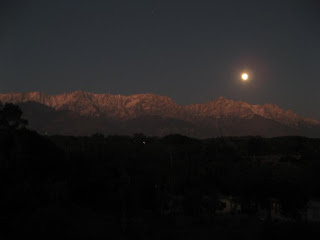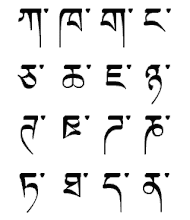
I have just returned from the McLeod Ganj, which right now from sunny Sarah’s vantage point is immersed in a thick dense cloud. Since I have been back I have not had the opportunity to visit “Da Ganj” as much as I used to mainly due to financial and time restraints. But this weekend I had some incentives for visiting the foggy “spiritual Disneyland” as it has been described by various journalists. This weekend HHDL was giving a two day teaching on the Diamond Cutter Sutra (rdo rje gcod pa, Vajracchedikā Prajñāpāramitā) at the request of the Korean sangha (Buddhist community). Most if not all of the teachings are sponsored and or requested by a sangha from a small group of Asian countries. Usually they are Korea, Taiwan, Russia (Kalmykia, Tuva, Buryatia)/ Mongolia and Singapore. These are always interesting times for one sees how the various Buddhist traditions, the monastic ones in particular, interact with one another. As I have mentioned before, in my class we have students from Korea, Taiwan, Vietnam and Singapore, and most of these students are also well learned in their respective traditions. At the beginnings of these teachings the monastics from whichever particular country will lead the initiatory chants in their traditional style. Like this morning, the slow steady and mindful beat of a woodblock was heard reverberating around the main temple as the Koreans chanted. I remember once when I went to a teaching sponsored by the Russian sangha three years ago, how the Mongolian monks with their intricate throat singing overtonal manipulations chanted the chant for the mandala offering. I was heavily struck by that experience.
It has been some time since I have been to any HHDL teachings, mostly because I normally like to take that time to catch-up on some studies. But Gen la gave us the time off to go, and Sarah made a surprise holiday so I decided to take advantage of the opportunity. Also there are some old dear friends visiting which I might not have otherwise gotten the chance to kick it with them. I was very elated to see them. It is always a treat to see the HHDL, though during the teachings the topics tend to be way over my head in English and definitely in Tibetan. Going to teachings is a good community event. Almost everyone is there and when sitting amongst Tibetans one is never left out. You are guaranteed to be taken care of. At the teachings you have your ole’ skool dharma bums and neophytes in attendance with their own particular style and flavor, all trying to digest the information coming to them by way of a translator. For the Westerns, there are always translations broadcasted by radio in English, and these days even Spanish of which I am particularly fond of listening to. Also the direct Tibetan teachings are broadcasted all throughout Dharamshala so that those who don’t have the chance to attend can listen in. Waiting for the bus at Sarah one student had his radio tuned in already.
The general process for getting up to “Da Ganj” the cheap way is to take a bus from Sarah, when there is one, for about 10 INR to lower Dharamshala and then from there, if there is a huge crowd waiting, fight and shove, American football style, to get into a shared jeep to McLeod. The shared jeep rides are rather uncomfortable. One is crammed in like sardines in a can, for the driver gets paid per how many heads are in. That is another ten rupees. The total time this takes from Sarah to McLeod Ganj is one hour to an hour and a half. It is quite an exhausting ordeal especially during monsoon.
There are more teachings coming up in the next couple of months, though I don’t know as of yet if I will attend all them, I will probably like this teaching attend it partially which seems to work for me for in this way I can still get some studying in.
As far as this pass week goes, there was not too much going on. I had quite a long sleeping spell on Tuesday because I was so exhausted. I get 7 hours of sleep everyday, but it don’t seem like it is cutting it. At the beginning of the course I was getting barely 6. But I think that seven hours is good, if I could do eight I would but so far no go.
We are now on the last chapter in the introductory path of reasoning “rigs lam chung ngu” Substantial and Isolated Phenomenon (rdzas chos ldog chos). Our previous chapter was on Generalities and Instances or Universals and Particulars (spyi bye drag), of which I just came to discover has had a long line of discussion going to antiquity in the western philosophical traditions. Even though each proceeding chapter gets increasing difficult and complex, it tends to be related to the previous topic studied which I find so helpful. Substantial and Isolated Phenomenon so far seems to organizes all of the phenomenon that we have studied so far into eight groups. One such group, Substantial Phenomenon, must have phenomenon that meet a specific criteria, like pot (bum pa) is a substantial phenomenon because it has a common locus such that (1) it is an established base i.e. it exists, (2) it is itself, (3) non-it is not it and (4) its isolate i.e. reversed from not being itself is not mutually exclusive with substantial phenomenon (khyod gzhi grub, khyod khyod rang yin, khyod ma yin pa khyod ma yin, khyod kyi ldog pa rdzas chos dang mi ‘gal yang yin pa’i gzhi mthun pa), recall that “it” (khyod) acts like “x” in mathematics where one has to find “x”. In this chapter there are seven other phenomenons that have similar requirements like the above and it gets quite confusing keeping track of them in debate since they are all so similar sounding. Anyhow, we are getting to the point where Gen la will point out distinctions between the four philosophical schools that we will be studying in the future which gives us a sneak peak in what is to come.
Yesterday I met an Israeli monk on the street that I was curious about when I first came to “Da Ganj” in ’05. I use to go to every teachings I could then, and I remember seeing in a ocean of maroon this one monk who was obviously not Tibetan, but just kickin’ there listening directly to the teachings. I had no idea who he was or where he was from, until one day I was circumambulating in the main temple while a debate session was going on in the courtyard. And so after my oblations and went down to investigate and saw this monk cutting into another in debate. By the time I got to where it was happening there was a small crowd of old Tibetans listening in watching this strange white monk doing his thing. After the debate was over I asked the monk in Tibetan where was he from and to my surprise he said Israel. He was in the program for the full time, a true Geshe in training, and now I assume that at time that he was in the Perfection of Wisdom class. I was surprised for up until that time I have met few Israelis deeply interesting in Buddhism nevertheless one that had taken on the maroon robes. Then, McLeod Ganj was and is still known to be full of Israelis backpackers, many just released from mandatory military service, to chill, relax and have a good time. I told him that I was attending Sarah within the year and that I was interested in the course that he is going through. He wished me luck and that was that. Since then I have seen him a few times (including once at Sarah where he sat as defender when the previous class had an all-night debate) and we will usually chat briefly. But this time it was in a mode of congratulations towards me for getting in the course and for me it was like completing a circle. It is weird to think also that in a couple of years this same monk might be clapping in front of my face.
Another Western monk, this one American, congratulated me last week. This one is quite a translator trained in the FPMT (Lotsawa Rinchen Zangpo) translator program a few years back. I sat next to him by chance at a teaching in the fall of ’07 and we started talking for I noticed that he had great insight into the Dharma and he spoke Tibetan really good. We talked a bit about what led us to where we were now and I told him what I was up to and what my plans were with my Tibetan language study. He was just so friendly and laid back. After the lunch break he presented me with a small donation for my studies, in which I was flabbergasted, I couldn’t take it from a monk. It is supposed to be the other way around. But he insisted, not taking no for an answer, stating that there are not many folks out there with enough motivation, interested in taking the time to do the work monk, lay or otherwise. I wasn’t sure if I was the right person for this but I give in and I held on to the donation for three years until I was accepted into the philosophy program in which it was included in my first three months tuition for the course. It was last weekend up the hill that I received the opportunity to thank him for that, for being farseeing three years back. For though then I wanted to take the course, I had no idea if I would have gotten in or not. Through those intermediary years I wondered, “what if I do not get in?” But that did not happen, in both cases with the Israeli and the American monk I felt a circle close and another open. I am glad that there are cool Western monastics around that I have befriended, for I have met many who are not so cool and I’ve often wondered why did they become monks or nuns. But that might be another entry for the future.
Pax





